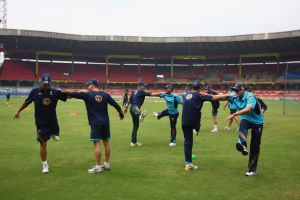Turning on the Lights: A Fresh Look at Cricket Warming Up
 Sam Lavery is PitchVision Academy's new monthly columnist: A coach with wide experience in the UK, Sam is Academy Director at Portsmouth Grammar School as well as a coach at Hampshire CCC and Burridge CC.
Sam Lavery is PitchVision Academy's new monthly columnist: A coach with wide experience in the UK, Sam is Academy Director at Portsmouth Grammar School as well as a coach at Hampshire CCC and Burridge CC.
Why exactly do we warm up?
I have coached at quite a few clubs in recent years and as I've travelled around the cricket circuit I see warm ups have improved no end with more action, excitement, and diversity.
However I've also seen some fundamental mistakes and chances missed.
I think that's because in all the clamour for warm up drills we have forgotten why we do them. And when we forget the reasons for warm ups we don't make the most of them.
Having spent the last few years working closely with Mike Main - Hampshire CCC Strength and Conditioning Coach - I have seen that warms up are all about preparing us for maximal performance, maximal power and maximal muscle contraction.
This means switching on as many muscle in our body as we can, and no amount of running around will ever achieve this.
Think about how long we spend developing techniques to allow players to generate power: controlling head and base position, maintaining alignment or the synchronisation of movements. The warm up is simply an extension of this aim. Physiologically, there are boxes that need ticking and pathways that need activating if we are to maximise the control of our bodies.
Turning on the lights
What does this mean for your warm up?
You are looking to "turn on" both the glutes, the powerhouse muscles of the body, and the core muscles; the stabilisers that help us control our position and posture.
By activating their core, bowlers can minimise technical deficiencies in their action, improving alignment, control and pace. For example, a 1st XI bowler at Portsmouth Grammar School that I coach, is able to improve his technique by simply following 5 minutes of core preparation.
The same is true with the glutes where - over 2-3 weeks of regular work - bowlers can maximise approach speed to the crease and minimise the collapse in their knees as they land, allowing them to carry more momentum through the crease.
How does this work?
If you imagine a muscle being like a grid that is 100 cells by 100 cells, there are potentially 10,000 muscle cells that can either work if they are activated and firing, providing assistance to a movement, or, they can remain dormant and ineffective if they are not switched on.
Yes, like a light switch.
Research has show that just a third of the muscle cells that make up the glutes are active when a person is walking. That increases to between a half and two thirds following a generic warm up that involves running and some fielding drills.
If we want to prepare our bodies to generate maximum power, and exude maximal control then we want it to be close to 100%. That mean activating the glutes and the core as part of a warm up.
The same applies to fielders and wickers keepers trying to control posture in low positions whilst moving dynamically yet precisely. It's also the same for batsmen trying to maintain body shape and balance through the shot to position themselves close to the ball, as well as to generate power. How many times to we really prepare our batsmen physically before and net, or before they walk out of the middle?
From what I see not enough.
For me, activating our glutes and core is a pivotal part of any warm up, whatever a players role.
So, do you do it?
And what are the simplest and most effective ways to involve these ideas of muscle activation into your warm up or during a game?
- Login to post comments

